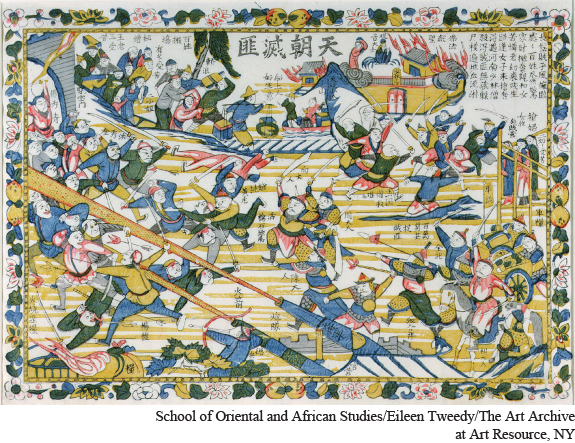The Crisis Within
AP® EXAM TIP
Here is another example of a continuity in history: an empire falling due to internal and external factors.
In many ways, China was the victim of its own earlier success. Its robust economy and American food crops had enabled substantial population growth, from about 100 million people in 1685 to some 430 million in 1853. Unlike in Europe, though, where a similar population spurt took place, no Industrial Revolution accompanied this vast increase in the number of people, nor was agricultural production able to keep up. Neither did China’s internal expansion to the west and south generate anything like the wealth and resources that derived from Europe’s overseas empires. The result was growing pressure on the land, smaller farms for China’s huge peasant population, and, in all too many cases, unemployment, impoverishment, misery, and starvation.
Guided Reading Question
▪CAUSATION
What accounts for the massive peasant rebellions of nineteenth-century China?
Furthermore, China’s famed centralized and bureaucratic state did not enlarge itself to keep pace with the growing population. Thus the state was increasingly unable to effectively perform its many functions, such as tax collection, flood control, social welfare, and public security. Gradually the central state lost power to provincial officials and local gentry. Among such officials, corruption was endemic, and harsh treatment of peasants was common. According to an official report issued in 1852, “Day and night soldiers are sent out to harass taxpayers. Sometimes corporal punishments are imposed upon tax delinquents; some of them are so badly beaten to exact the last penny that blood and flesh fly in all directions.”2 Finally, European military pressure and economic penetration during the first half of the nineteenth century (see pages 838–41) disrupted internal trade routes, created substantial unemployment, and raised peasant taxes.
This combination of circumstances, traditionally associated with a declining dynasty, gave rise to growing numbers of bandit gangs roaming the countryside and, even more dangerous, to outright peasant rebellion. Beginning in the late eighteenth century, such rebellions drew on a variety of peasant grievances and found leadership in charismatic figures proclaiming a millenarian religious message. Increasingly they also expressed opposition to the Qing dynasty because of its foreign Manchu origins. “We wait only for the northern region to be returned to a Han emperor,” declared one rebel group in the early nineteenth century.3

The culmination of China’s internal crisis lay in the Taiping Uprising, which set much of the country aflame between 1850 and 1864. This was a different kind of peasant upheaval. Its leaders largely rejected Confucianism, Daoism, and Buddhism alike, finding their primary ideology in a unique form of Christianity. Its leading figure, Hong Xiuquan (1814–1864), proclaimed himself the younger brother of Jesus, sent to cleanse the world of demons and to establish a “heavenly kingdom of great peace.” Nor were these leaders content to restore an idealized Chinese society; instead they insisted on genuinely revolutionary change. They called for the abolition of private property, a radical redistribution of land, the end of prostitution and opium smoking, and the organization of society into sexually segregated military camps of men and women. Hong fiercely denounced the Qing dynasty as foreigners who had “poisoned China” and “defiled the emperor’s throne.” His cousin, Hong Rengan, developed plans for transforming China into an industrial nation, complete with railroads, health insurance for all, newspapers, and widespread public education.
AP® EXAM TIP
Compare the causes and results of the Taiping Uprising to those of the rebellions you learned about in Chapter 16.
Among the most revolutionary dimensions of the Taiping Uprising was its posture toward women and gender roles. This outlook reflected its origins among the minority Hakka people of southern China, where women were notably less restricted than Confucian orthodoxy prescribed. During the uprising, Hakka women, whose feet had never been bound, fought as soldiers in their own regiments; in liberated regions, Taiping officials ordered that the feet of other women be unbound. The Taiping land reform program promised women and men equal shares of land. Women were now permitted to sit for civil service examinations and were appointed to supervisory positions, though usually ones in which they exercised authority over other women rather than men. Mutual attraction rather than family interests was promoted as a basis for marriage.
None of these reforms were consistently implemented during the short period of Taiping power, and the movement’s leadership demonstrated considerable ambivalence about equality for women. Hong himself reflected a much more traditional understanding of elite women’s role when he assembled a large personal harem and declared: “The duty of the palace women is to attend to the needs of their husbands; and it is arranged by Heaven that they are not to learn of the affairs outside.”4 Nonetheless, the Taiping posture toward women represented a sharp challenge to long-
With a rapidly swelling number of followers, Taiping forces swept out of southern China and established their capital in Nanjing in 1853. For a time, the days of the Qing dynasty appeared to be over. But divisions and indecisiveness within the Taiping leadership, along with their inability to link up with several other rebel groups also operating separately in China, provided an opening for Qing dynasty loyalists to rally and by 1864 to crush this most unusual of peasant rebellions. Western military support for pro-
Thus the Qing dynasty was saved, but it was also weakened as the provincial gentry consolidated their power at the expense of the central state. The intense conservatism of both imperial authorities and their gentry supporters postponed any resolution of China’s peasant problem, delayed any real change for China’s women, and deferred vigorous efforts at modernization until the communists came to power in the mid-